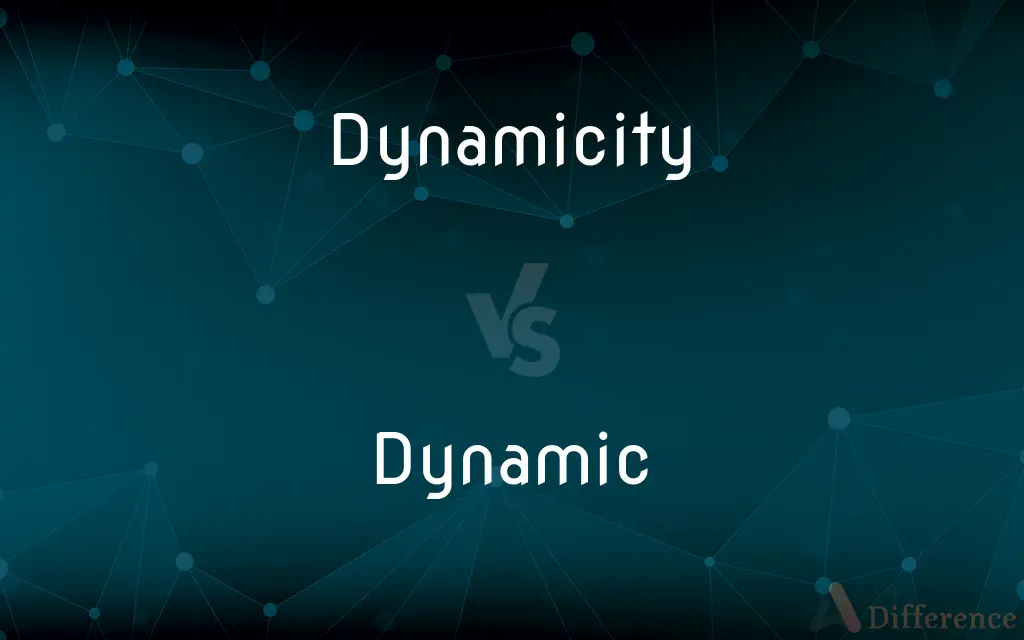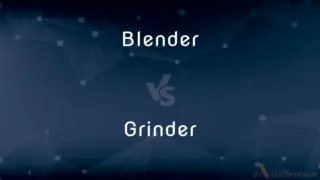Dynamicity vs. Dynamic — What's the Difference?
By Tayyaba Rehman & Urooj Arif — Updated on March 27, 2024
Dynamicity emphasizes the quality of being dynamic, focusing on constant change or activity. Dynamic refers to forces or processes causing motion or change, often implying energy and power.

Difference Between Dynamicity and Dynamic
Table of Contents
ADVERTISEMENT
Key Differences
Dynamicity embodies the quality or state of being dynamic, emphasizing the capacity for continuous change, growth, or activity. It is often used to describe systems, environments, or attributes that are characterized by constant evolution and adaptability. Dynamic, whereas, describes objects, individuals, or situations that are characterized by energy, force, or effectiveness in causing change. It implies movement, power, or the ability to influence.
While dynamicity serves as a noun focusing on the attribute of being dynamic, dynamic can function as both an adjective and a noun, describing both the nature of change and the agents causing it. Dynamicity captures the essence of variability and transformation, dynamic highlights the presence of energy and motion.
Dynamicity is particularly useful in contexts that discuss the inherent qualities or conditions conducive to change and adaptability, such as in social dynamics, technology, or biology. Dynamic, on the other hand, is more versatile, applying to physical forces, personal qualities, and abstract concepts that embody or provoke action and change.
In discussing personalities or leadership styles, dynamicity may refer to the ongoing ability to adapt and respond to new challenges, emphasizing a trait of versatility and resilience. Dynamic, whereas, might describe someone's immediate presence and impact, showcasing their energy and capability to inspire or drive progress.
The concept of dynamicity is integral to fields like software development and business, where it underscores the importance of flexibility and responsiveness in systems and strategies. Dynamic, conversely, is often associated with the forces that propel innovation and efficiency, such as dynamic markets or dynamic leadership, highlighting the influence and momentum behind change.
ADVERTISEMENT
Comparison Chart
Definition
Quality of being dynamic; characterized by constant change.
Pertaining to or causing motion, change; energetic or forceful.
Function
Noun
Both adjective and noun
Usage Context
Describes systems or attributes
Describes forces, qualities, situations, or objects
Connotation
Emphasizes adaptability and continuous evolution
Emphasizes energy, power, and the capability to induce change
Typical Fields
Social dynamics, technology, biology
Physics, personality description, leadership, innovation
Compare with Definitions
Dynamicity
A characteristic of systems or processes that undergo constant evolution.
The dynamicity of the software enables it to update itself with new features regularly.
Dynamic
Energetic and forceful.
Her dynamic presentation captivated the audience.
Dynamicity
The state of being vibrant and active.
The city's dynamicity attracts young professionals looking for opportunities.
Dynamic
Relating to forces causing motion or change.
The study focuses on the dynamic forces acting upon the bridge.
Dynamicity
Reflecting or promoting change and growth.
Their approach to education emphasizes the dynamicity of learning environments.
Dynamic
Involving or characterized by energy or effective action.
They lead a dynamic campaign that significantly raised awareness.
Dynamicity
Pertaining to the variability and adaptiveness in behavior or function.
The team's dynamicity was evident in how they handled the project's challenges.
Dynamic
Pertaining to the aspect of a language that expresses action or process.
Verbs are a dynamic part of speech, indicating actions.
Dynamicity
The quality of being dynamic; the ability to change or adapt effectively.
The dynamicity of the tech industry requires companies to innovate continuously.
Dynamic
Characterized by constant change, activity, or progress.
The dynamic nature of the market demands constant vigilance from investors.
Dynamicity
The condition of being dynamic
The dynamicity of the dataset makes it difficult to keep accurate.
Dynamic
Of or relating to energy or to objects in motion.
Dynamic
Of or relating to the study of dynamics.
Dynamic
Characterized by continuous change, activity, or progress
A dynamic housing market.
Dynamic
Characterized by much activity and vigor, especially in bringing about change; energetic and forceful.
Dynamic
Of or relating to variation of intensity, as in musical sound.
Dynamic
A force, especially political, social, or psychological
The main dynamic behind the revolution.
Dynamic
Changing; active; in motion.
The environment is dynamic, changing with the years and the seasons.
Dynamic economy
Dynamic
Powerful; energetic.
He was a dynamic and engaging speaker.
Dynamic
Able to change and adapt.
Dynamic
(music) Having to do with the volume of sound.
The dynamic marking in bar 40 is forte.
Dynamic
(computing) Happening at runtime instead of being predetermined at compile time.
Dynamic allocation
Dynamic IP addresses
The dynamic resizing of an array
Dynamic
Pertaining to dynamics, the branch of mechanics concerned with the effects of forces on the motion of objects.
Dynamic
(grammar) Of a verb: not stative, but fientive; indicating continued or progressive action on the part of the subject.
Dynamic
A characteristic or manner of an interaction; a behavior.
Watch the dynamic between the husband and wife when they disagree.
Dynamic
(physics) A moving force.
The study of fluid dynamics quantifies turbulent and laminar flows.
Dynamic
(music) The varying loudness or volume of a song or the markings that indicate the loudness.
If you pay attention to the dynamics as you play, it's a very moving piece.
Dynamic
(music) A symbol in a musical score that indicates the desired level of volume.
Dynamic
(grammar) A verb that indicates continued or progressive action on the part of the subject.
Dynamic
Of or pertaining to dynamics; belonging to energy or power; characterized by energy or production of force.
Science, as well as history, has its past to show, - a past indeed, much larger; but its immensity is dynamic, not divine.
The vowel is produced by phonetic, not by dynamic, causes.
Dynamic
Relating to physical forces, effects, or laws; as, dynamical geology.
As natural science has become more dynamic, so has history.
Dynamic
An efficient incentive;
They hoped it would act as a spiritual dynamic on all churches
Dynamic
Characterized by action or forcefulness or force of personality;
A dynamic market
A dynamic speaker
The dynamic president of the firm
Dynamic
Of or relating to dynamics
Dynamic
Expressing action rather than a state of being; used of verbs (e.g. `to run') and participial adjectives (e.g. `running' in `running water')
Common Curiosities
Can dynamic be used as a noun?
Yes, dynamic can function as both an adjective and a noun, describing the nature of change and the agents causing it.
What is dynamicity?
Dynamicity refers to the quality or state of being dynamic, highlighting constant change, adaptability, and activity.
What does it mean for a person to be described as dynamic?
A person described as dynamic is energetic, forceful, and capable of causing change or taking effective action.
Is dynamicity applicable only to technical or scientific contexts?
No, dynamicity can also apply to social, educational, and business contexts, emphasizing adaptability and continuous evolution.
Can a language be considered dynamic?
Yes, languages are dynamic in that they evolve and change over time, reflecting societal changes and cultural interactions.
What role does dynamicity play in leadership?
Dynamicity in leadership refers to the ability to adapt, respond to challenges, and inspire change and growth within an organization.
How does dynamic differ from dynamicity?
Dynamic describes forces, energy, or qualities causing motion or change, whereas dynamicity refers to the state or quality of being dynamic.
In what fields is the concept of dynamicity particularly relevant?
Dynamicity is relevant in fields that value adaptability and evolution, such as technology, social dynamics, and biology.
What is an example of a dynamic force?
Gravitational forces acting on celestial bodies are an example of dynamic forces causing motion and change.
Is dynamicity always positive?
While often viewed positively, dynamicity can present challenges, such as instability or unpredictability, in certain contexts.
How does dynamicity influence business strategies?
Dynamicity influences business strategies by encouraging flexibility and responsiveness to market changes and technological advancements.
How is dynamicity measured or observed?
Dynamicity can be observed in the ability of systems, individuals, or processes to adapt and evolve in response to changing conditions.
Can a situation be both dynamic and exhibit dynamicity?
Yes, a situation can be dynamic due to the forces at play and exhibit dynamicity through its potential for change and adaptation.
How do dynamic leaders impact an organization?
Dynamic leaders drive an organization forward through energy, vision, and the ability to enact and adapt to change, inspiring others to follow suit.
How do dynamic and dynamicity relate to innovation?
Both concepts are crucial to innovation; dynamic forces drive change, while dynamicity represents the capacity for continuous adaptation and growth.
Share Your Discovery

Previous Comparison
Blender vs. Grinder
Next Comparison
Microsuede vs. MicrofiberAuthor Spotlight
Written by
Tayyaba RehmanTayyaba Rehman is a distinguished writer, currently serving as a primary contributor to askdifference.com. As a researcher in semantics and etymology, Tayyaba's passion for the complexity of languages and their distinctions has found a perfect home on the platform. Tayyaba delves into the intricacies of language, distinguishing between commonly confused words and phrases, thereby providing clarity for readers worldwide.
Co-written by
Urooj ArifUrooj is a skilled content writer at Ask Difference, known for her exceptional ability to simplify complex topics into engaging and informative content. With a passion for research and a flair for clear, concise writing, she consistently delivers articles that resonate with our diverse audience.














































